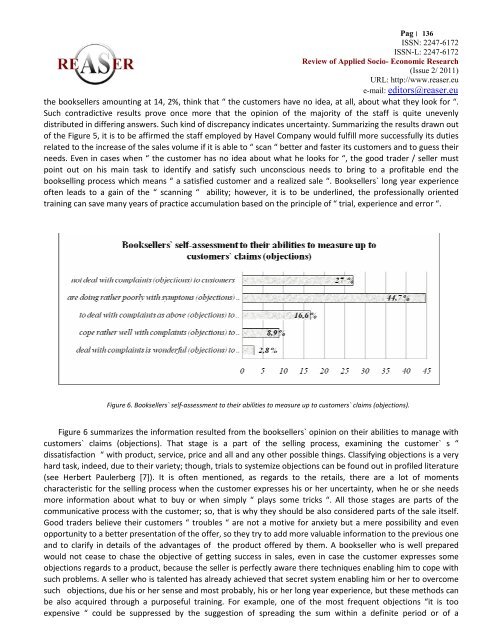Volume 2, ISSUE2/2011 - Review of Applied Socio-Economic ...
Volume 2, ISSUE2/2011 - Review of Applied Socio-Economic ...
Volume 2, ISSUE2/2011 - Review of Applied Socio-Economic ...
Create successful ePaper yourself
Turn your PDF publications into a flip-book with our unique Google optimized e-Paper software.
Pag׀ 136 ISSN: 2247-6172ISSN-L: 2247-6172<strong>Review</strong> <strong>of</strong> <strong>Applied</strong> <strong>Socio</strong>- <strong>Economic</strong> Research(Issue 2/ <strong>2011</strong>)URL: http://www.reaser.eue-mail: editors@reaser.euthe booksellers amounting at 14, 2%, think that “ the customers have no idea, at all, about what they look for “.Such contradictive results prove once more that the opinion <strong>of</strong> the majority <strong>of</strong> the staff is quite unevenlydistributed in differing answers. Such kind <strong>of</strong> discrepancy indicates uncertainty. Summarizing the results drawn out<strong>of</strong> the Figure 5, it is to be affirmed the staff employed by Havel Company would fulfill more successfully its dutiesrelated to the increase <strong>of</strong> the sales volume if it is able to “ scan “ better and faster its customers and to guess theirneeds. Even in cases when “ the customer has no idea about what he looks for “, the good trader / seller mustpoint out on his main task to identify and satisfy such unconscious needs to bring to a pr<strong>of</strong>itable end thebookselling process which means “ a satisfied customer and a realized sale “. Booksellers` long year experience<strong>of</strong>ten leads to a gain <strong>of</strong> the “ scanning “ ability; however, it is to be underlined, the pr<strong>of</strong>essionally orientedtraining can save many years <strong>of</strong> practice accumulation based on the principle <strong>of</strong> “ trial, experience and error “.Figure 6. Booksellers` self-assessment to their abilities to measure up to customers` claims (objections).Figure 6 summarizes the information resulted from the booksellers` opinion on their abilities to manage withcustomers` claims (objections). That stage is a part <strong>of</strong> the selling process, examining the customer` s “dissatisfaction “ with product, service, price and all and any other possible things. Classifying objections is a veryhard task, indeed, due to their variety; though, trials to systemize objections can be found out in pr<strong>of</strong>iled literature(see Herbert Paulerberg [7]). It is <strong>of</strong>ten mentioned, as regards to the retails, there are a lot <strong>of</strong> momentscharacteristic for the selling process when the customer expresses his or her uncertainty, when he or she needsmore information about what to buy or when simply “ plays some tricks “. All those stages are parts <strong>of</strong> thecommunicative process with the customer; so, that is why they should be also considered parts <strong>of</strong> the sale itself.Good traders believe their customers “ troubles “ are not a motive for anxiety but a mere possibility and evenopportunity to a better presentation <strong>of</strong> the <strong>of</strong>fer, so they try to add more valuable information to the previous oneand to clarify in details <strong>of</strong> the advantages <strong>of</strong> the product <strong>of</strong>fered by them. A bookseller who is well preparedwould not cease to chase the objective <strong>of</strong> getting success in sales, even in case the customer expresses someobjections regards to a product, because the seller is perfectly aware there techniques enabling him to cope withsuch problems. A seller who is talented has already achieved that secret system enabling him or her to overcomesuch objections, due his or her sense and most probably, his or her long year experience, but these methods canbe also acquired through a purposeful training. For example, one <strong>of</strong> the most frequent objections “it is tooexpensive “ could be suppressed by the suggestion <strong>of</strong> spreading the sum within a definite period or <strong>of</strong> a








